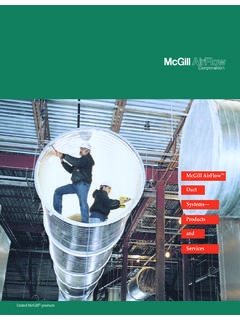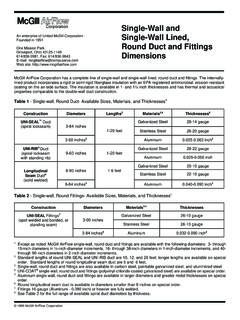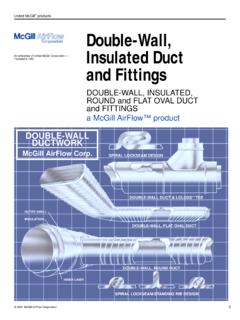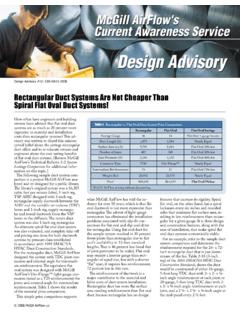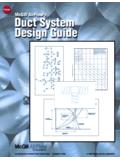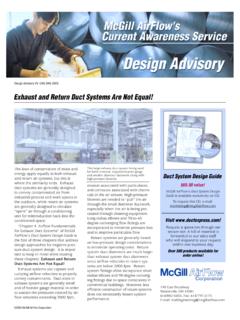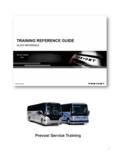Transcription of Leak Detective - McGill AirFlow
1 Why Test for LeakageLeak Detective Test CartsLeak Detective Calibrated Test Carts for Measuring the Leakage Performance of Duct SystemsUnited McGill ProductsNo duct system is airtight; all leak to some degree. If controlled, duct leakage can be less than 1/2 of 1 percent of the total system cfm. As leakage increases, more air (energy) is required to maintain design conditions, and this increases operating costs. To protect building owners against leakage and the resulting increase in operating costs, engi-neers are specifying the leakage parameters and verification testing.
2 Please refer to McGill AirFlow s System Pres-sure Testing for Leaks for a detailed discussion of leakage testing McGill and Leak Detective are registered trademarks, and McGill AirFlow and Duct Express are trademarks of United McGill Corporation. 2017 McGill AirFlow LLCa McGill AirFlow ProductOne Mission Park Groveport, Ohio 43125 614/829-1200, Fax: 614/829-1291 enterprise of United McGill Family owned and operated since 1951 Typical Standard Leak Detective Test Kit (8-inch unit shown)Leak Detective Test Cart Assemblies (4-, 5-, and 8-inch units shown)A Leak Detective Test Cart from McGill AirFlow makes it easy for you to measure duct system leakage.
3 We offer four standard sizes, each available either as a kit or mounted on a wheeled cart. Other sizes are available as non-standard items. Leak Detective carts, orifice tubes, and test kit components can be ordered individually. A standard Leak Detec-tive Test Cart contains the following equipment:1. Calibrated orifice tube2. Certified calibration chart3. OSHA-approved fan with damper4. Two U-tube manometers5. Vinyl tubing6. Dye7. 10-ft flex duct, adapter, and clamps The standard test cart contains a 4-, 5-, 6-, or 8-inch-diameter orifice tube calibrated for positive pressure system testing.
4 The 4-inch orifice tube incorporates a diffuser plate to straighten the air as it leaves the fan s nozzle. The fan in the 4-inch leakage test cart will operate on 110-volt, single-phase, 50- or 60-hertz current. It can also be ordered for 220-volt 5-inch fan will operate on 110-volt, single- phase, 60-hertz current, but can be wired for 220-volt operation. The 5-inch fan can be ordered for 50-hertz applications. The 6- and 8-inch carts use a 220-volt, single-phase, 60-hertz fan that is equipped with a L6-30 turn-lock plug for required 30-amp service.
5 The fan can be ordered for 50-hertz applications but is not available for 110-volt operation. Cart AssembliesSmoke Delivery SystemOrifice TubesCalibration ServicesComplete Leak Detective Smoke Delivery System (mounted to a 5-inch cart assembly)We can recalibrate McGill AirFlow orifice tubes and calibrate tubes that you supply. All types of tubes can be calibrated for positive pres-sure, negative pressure, or a combination of positive and negative pressure. All three standard fans are OSHA approved, and come with an inlet damper and can also supply all test kits mounted on a hand cart for easy portability.
6 All you do is wheel the durable, metal cart to a test site and connect your flexible hose to the orifice tube. Convenient holders are provided for the cali-bration chart and instruction booklet. You can also purchase a hand cart as a separate item and mount your existing test kit on use of smoke during the testing process can make locating sources of leakage faster and easier. As a complementary accessory to our leakage test kits and cart assemblies, McGill AirFlow offers a smoke machine and a complete smoke delivery system. A smoke delivery system can be purchased to attach to your cart assembly.
7 The expected accuracy of all our orifice tubes at the time of shipment is 2 percent of the indicated flow rate. All tubes are supplied with calibration charts and tables certified by a professional engineer (see Figure 1). You can order our standard or nonstandard orifice tubes individually, in lieu of an entire test cart or kit. Nonstandard orifice tubes are specially designed and calibrated according to the required volume flow. They can be cali-brated for use in both positive and negative static pressure systems. When ordering a non-standard tube, the required volume flow, test pressure, and calibration requirements should be specified.
8 Standard 4-inch and 5-inch orifice tubes are calibrated against master tubes, which have been certified to an accuracy of percent by an independent laboratory on equipment traceable to the National Institute for Standards and Technology (NIST). The standard 6-inch and 8-inch orifice tubes are calibrated against an orifice plate machine ground to the nearest inch and mounted in a ASME metering 1 Orifice Tube calibration Chart024 6 8 10 010 0200300400500 Figure 2 CFM versus Test Static PressureMaximum Test Leakage (cfm)Required Test Static Pressure (in wg)Figure 3 CFM versus Test Static PressureMaximum Test Leakage (cfm)Required Test Static Pressure (in wg)Figures 2 and 3 are graphs showing the approximate operating limits of each Leak Detective Test Cart.
9 The graphs plot static pressure versus volume flow. At a given test pressure, each unit can deliver air volumes (cfm) up to the maximum value indicated by the curve. To facilitate your selection of a test cart, visit Leak Detective Test Kit Tools on McGill AirFlow s web site a Leak Detective Test CartLTK-5 LTK-4 LTK-8 LTK-6 Leakage SpecificationsMcGill AirFlow maintains that lower allowable leakage rate specifications, as related to HVAC duct system designs, are essential in meeting the demand for lower energy costs. McGill Air-Flow recommends designers of HVAC duct systems incorporate the American Air Balance Council s (AABC) 2002 National Stan-dards for Total System Balance Duct Leak-age Testing (refer to Chapter 35) for allowable leakage rates in obtaining LEED qualified and sustainable energy efficiency.
10 McGill AirFlow further recommends specifying that the entire system, which includes all ductwork and system components (VAV boxes, fire/smoke dampers, etc.), be leak tested at the maximum system operating pressure in order to ensure conformance to the lower allowable leakage rate of SystemMinimum Test Pressure5 Maximum Allowable LeakageFractional horsepower fan system; fan coils, small exhaust/supply fansSmall systems; split DX systems usually under 2,000 cfmVAV and CAV boxes and associated downstream duct1 Single-zone, multi-zone, low pressure VAV and CAV systems2, return ducts, and exhaust duct systemsAll constant volume ducts in chases and concealed spaces, main return ducts on VAV and CAV sys-tems, main ducts on exhaust or supply systemsSupply ducts for VAV and CAV systemsHigh-pressure induction wg2%1-inch wg2%1-inch wg2%2-inch wg2%3-inch wg1%4-inch wg31%6-inch It is assumed that the box damper is on the inlet side of the box.
